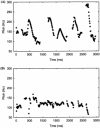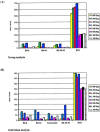Cerebral mechanisms of prosodic sensory integration using low-frequency bands of connected speech
- PMID: 15929092
- PMCID: PMC6871763
- DOI: 10.1002/hbm.20147
Cerebral mechanisms of prosodic sensory integration using low-frequency bands of connected speech
Abstract
Even if speech perception has been reported to involve both left and right hemispheres, converging data have posited the existence of a functional asymmetry at the level of secondary auditory cortices. Using fMRI in 12 right-handed French men listening passively to long connected speech stimuli, we addressed the question of neuronal networks involved in the integration of low frequency bands of speech by comparing 1) differences in brain activity in two listening conditions (FN, NF) differing in the integration of pitch modulations (in FN, low frequencies, obtained by a low-pass filter, are addressed to the left ear while the whole acoustic message is simultaneously addressed to the right ear, NF being the reverse position); 2) differences in brain activity induced by high and low degrees of prosodic expression (expressive vs. flat); and 3) effects of the same connected speech stimulus in the two listening conditions. Each stimulus induced a specific cerebral network, the flat one weakening activations which were mainly reduced to the bilateral STG for both listening conditions. In the expressive condition, the specific sensory integration FN results in an increase of the articulatory loop and new recruitments such as right BA6-44, left BA39-40, the left posterior insula and the bilateral BA30. This finding may be accounted for by the existence of temporal windows differing both in length and in acoustic cues decoding, strengthening the "asymmetric sampling in time" hypothesis posited by Poeppel (Speech Commun 2003; 41:245-255). Such an improvement of prosodic integration could find applications in the rehabilitation of some speech disturbances.
Hum Brain Mapp, 2005. (c) 2005 Wiley-Liss, Inc.
Figures




Similar articles
-
Neural correlates of the perception of contrastive prosodic focus in French: a functional magnetic resonance imaging study.Hum Brain Mapp. 2013 Oct;34(10):2574-91. doi: 10.1002/hbm.22090. Epub 2012 Apr 5. Hum Brain Mapp. 2013. PMID: 22488985 Free PMC article.
-
Cerebral mechanisms of prosodic integration: evidence from connected speech.Neuroimage. 2005 Feb 15;24(4):937-47. doi: 10.1016/j.neuroimage.2004.11.003. Epub 2004 Dec 19. Neuroimage. 2005. PMID: 15670670 Clinical Trial.
-
Determining hierarchical functional networks from auditory stimuli fMRI.Hum Brain Mapp. 2006 May;27(5):462-70. doi: 10.1002/hbm.20245. Hum Brain Mapp. 2006. PMID: 16568419 Free PMC article.
-
The neuroanatomical and functional organization of speech perception.Trends Neurosci. 2003 Feb;26(2):100-7. doi: 10.1016/S0166-2236(02)00037-1. Trends Neurosci. 2003. PMID: 12536133 Review.
-
[Auditory perception and language: functional imaging of speech sensitive auditory cortex].Rev Neurol (Paris). 2001 Sep;157(8-9 Pt 1):837-46. Rev Neurol (Paris). 2001. PMID: 11677406 Review. French.
Cited by
-
Neuroanatomical markers of speaking Chinese.Hum Brain Mapp. 2009 Dec;30(12):4108-15. doi: 10.1002/hbm.20832. Hum Brain Mapp. 2009. PMID: 19530216 Free PMC article.
-
How do morphological alterations caused by chronic pain distribute across the brain? A meta-analytic co-alteration study.Neuroimage Clin. 2017 Dec 21;18:15-30. doi: 10.1016/j.nicl.2017.12.029. eCollection 2018. Neuroimage Clin. 2017. PMID: 30023166 Free PMC article.
-
Perception of Filtered Speech by Children with Developmental Dyslexia and Children with Specific Language Impairments.Front Psychol. 2016 May 30;7:791. doi: 10.3389/fpsyg.2016.00791. eCollection 2016. Front Psychol. 2016. PMID: 27303348 Free PMC article.
-
Neural correlates of the perception of contrastive prosodic focus in French: a functional magnetic resonance imaging study.Hum Brain Mapp. 2013 Oct;34(10):2574-91. doi: 10.1002/hbm.22090. Epub 2012 Apr 5. Hum Brain Mapp. 2013. PMID: 22488985 Free PMC article.
-
Speech perception at the interface of neurobiology and linguistics.Philos Trans R Soc Lond B Biol Sci. 2008 Mar 12;363(1493):1071-86. doi: 10.1098/rstb.2007.2160. Philos Trans R Soc Lond B Biol Sci. 2008. PMID: 17890189 Free PMC article.
References
-
- Baddeley AD, Emslie H, Nimmo‐Smith I (1992): Speed and capacity of language processing (SCOLP) test. Bury St Edmunds (UK): Thames Valley Test Co.
-
- Belin P, Zilbovicius M, Crozier S, Thivard L, Fontaine A, Masure MC, Samson Y (1998): Lateralization of speech and auditory temporal pocessing. J Cogn Neurosci 10: 536–540. - PubMed
-
- Belin P, Zatorre RJ, Lafaille P, Ahad P, Pike B (2000): Voice‐selective areas in human auditory cortex. Nature 403: 309–312. - PubMed
-
- Binder JR, Frost MS (1998): Functional MRI studies of language processing in the brain. Neurosci News 1: 15–23.
-
- Binder JR, Frost JA, Hammeke TA, Rao SM, Cox RW (1996): Function of the left planum temporale in auditory and linguistic processing. Brain 119: 1239–1247. - PubMed
Publication types
MeSH terms
LinkOut - more resources
Full Text Sources
Miscellaneous

